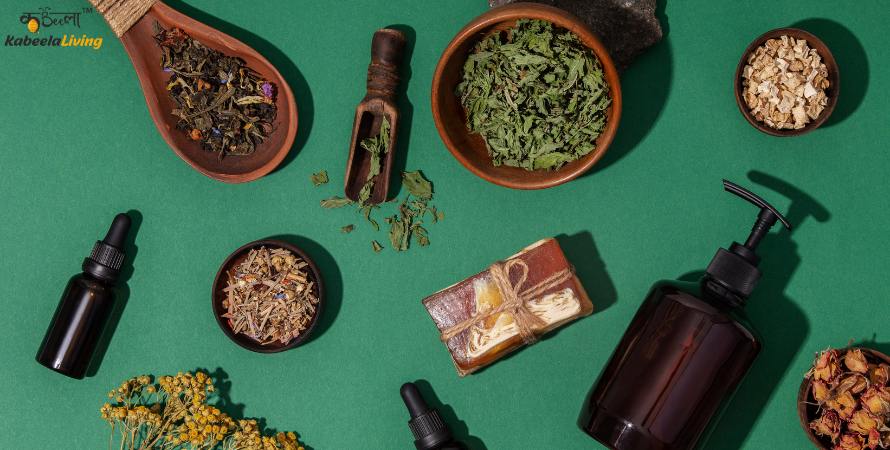
Healthy pantry essentials- ayurvedic herbs
Share
Spices and herbs are vital for a healthy digestive system. Every meal should include some of the spices you have in your kitchen cabinet because they all aid in digestion. My best advice is to make them as simple to locate and grab as you can. Which herbs and spices are the best and must be consumed regularly? The complete list is provided below.
ESSENTIAL PANTRY AYURVEDIC HERBS
More than just salt and pepper, spices have many more uses. These are pure culinary gold. Here are some top pantry necessities, whether you’re trying to eat healthily or are launching yourself into an Ayurvedic diet to treat a condition.
Turmeric/Curcumin/Haldi
Curcumin, a natural antioxidant, has anti-inflammatory properties, anti-aging properties, anti-Alzheimer’s disease properties, and also anti-depressant properties.
Ginger
Ginger’s anti-inflammatory, anti-nausea, and other characteristics may have a variety of positive effects on health. In addition to other things, it might aid in weight loss, arthritis management, and menstrual cramp relief.
Ginger comes in a variety of forms, including fresh, dried, powdered, oil, and juice. Along with processed foods, over-the-counter medicines, and cosmetics, it is used in numerous recipes.
Cloves
Not all cuisines in the world use cloves, nevertheless, just like Indian food. They are also often used to flavor curries, meat dishes, hot drinks like chai, and other dishes in Middle Eastern, North African, and East Asian cuisine.
A key component of garam masala and well-known for its potent anise flavors is cloves.
Cinnamon
Cinnamon is one of the most antioxidant-rich spices, with a powerful flavor that has a sweet undertone. Ceylon cinnamon’s therapeutic qualities are brought on by a substance in it called cinnamaldehyde. The use of it is also really simple. In your tea, on your dairy-free yogurt, or on your sweets, sprinkle.
Coriander Powder
The most popular spice in every Indian spice rack is probably coriander, also known as dry dhania powder.
While cilantro exclusively refers to the dried leaves of the plant, coriander can also refer to the seeds or powder of the plant. If you’ve ever eaten cilantro, you’ll be aware that coriander isn’t particularly hot but rather snappy and energizing. It is one of the world’s oldest spices and is recognizable for its distinctive golden-yellow colors and citrus-like fragrances.
ayurvedic herbsayurvedic herbs
Cumin seeds
Popular spice cumin, originally from Asia, is today mostly manufactured in India and Iran. Due to its potent, smokey, and earthy flavor, it is one of the most widely used spices in Indian food, especially in dals and curries, but also in bread and savory drinks!
When you can smell its distinctive toasted aroma, roast the seeds for 30 to 60 seconds. The seeds are then ground into a powder, which is then immediately cooled and mixed with the remaining ingredients in the meal.
Mustard Seeds
In South Indian cuisine, mustard seeds, also known as rai, hold the title of being one of the most preferred tempering spices, despite cumin being one of the most widely used in North Indian cooking.
A typical ingredient in rice recipes and curries, such as Chicken Coconut Curry with Mango, these crunchy seeds are renowned for their smokey, nutty flavor. Before adding the additional ingredients, many South Indian recipes instruct simmering the seeds in heated oil to release their flavor.
Conclusion:
Since ancient times, spices have expanded over the world, enhancing cuisine with incredible flavor. It’s easy to argue that today’s consumers of spices are a little pampered when you consider the history of the spice trade. Even with all of the spices on this long list, it merely provides a glimpse into the genuinely crowded Indian spice closet.
By adding herbs and spices to an already gorgeous mixture, every meal or beverage’s flavor is improved. They are indispensable in every diet since, in addition to their culinary advantages, they provide a variety of healing capabilities.
As you prepare your next handmade Indian cuisine, keep an eye out for spices like black cardamom, amchur (dried mango powder), ajwain (carom seeds), Hing(asafoetida), black pepper, curry leaves, fennel seeds, dried fenugreek leaves, green cardamom, red chili, and cayenne to add rich flavors.
Check out Kabeela living’s selection of ayurvedic herbs to turn family dinners into occasions, we infuse all of your foods with fragrant spices.
Tags: ayurvedic, ayurvedic herbs, herbs, Kabeela Living
